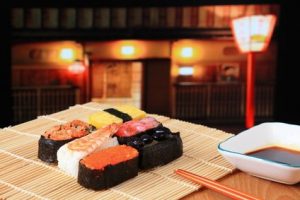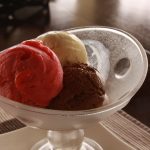 Japanese cuisine has a rich and storied history based as much upon the unique culture of the region and nation as it is upon its native foods. For any traveller looking to experience the heart and soul of Japan, the mouth and stomach are an ideal place to start, especially in the city of Kyoto.
Japanese cuisine has a rich and storied history based as much upon the unique culture of the region and nation as it is upon its native foods. For any traveller looking to experience the heart and soul of Japan, the mouth and stomach are an ideal place to start, especially in the city of Kyoto.
If you’re looking to travel to and book accommodations in Kyoto, do so with each of your meals in mind, as the foods, dishes and styles of eating in Kyoto are easily as memorable as its shrines, architecture, history and museums. Whether you dine on traditional homestyle cooking or the animal-friendly style of eating enjoyed by Japanese Buddhist monks, here are ten dishes that should not be missed when you venture out on holiday to Japan.
Obanzai Ryori
Kyoto’s most traditional cooking is that which is done in the home, and it goes by the name Obanzai Ryori. Made up of many different, small, simple dishes, it utilizes local produce that is in-season and full-flavoured. This style of cooking, although it is unassuming, is popular in Kyoto restaurants.
Shojin Ryori
This style of food and eating developed out of the ascetic religious practices of Buddhist monks. Completely free of meat or fish, Shojin Ryori is always strictly vegetarian and often involves tofu. In fact, it is sometimes referred to as “tofu cuisine.” If you prefer vegetarian meals, stay in either the Nanzenji or Arashiyama districts of Kyoto, as these are well-known for their tofu cuisine.
Tsukemono
Tsukemono is simply a pickled vegetable or vegetables served alongside a meal or tea ceremony. Tsukemono in Kyoto often goes by its own name of Kyotsukemono because it has a flavour and preparation all its own. There are three main types of Kyotsukemono:
• Suguki, which is a type of pickled turnip
• Shibazuke, which is a pickled combination including blossoms, ginger, eggplant and more
• Senmaizuke, which is made from Japan’s largest turnip variety
Sukiyaki
This dish features thinly sliced and exceptionally high-quality beef and other local ingredients that have been simmered in a soy sauce broth. Served in an iron hot pot, Sukiyaki has been one of Japan’s most popular beef dishes since the 19th century.
Shabu-Shabu
Similar to sukiyaki, Shabu-Shabu is a more contemporary dish in Japanese cuisine. The difference is that after the ingredients have been cooked in the broth in the hot pot, they are then dipped in a sesame sauce or ponzu just before they are eaten.
The Bento
The bento is the original Japanese lunch on the go. Bento can literally be translated as “boxed lunch,” but the experience of a bento is much more. While the first bentos were simple rice balls, sea kelp and pickled plum wrapped in leaves, today’s bentos run the gamut of offerings. Most Kyoto restaurants utilize the best seasonal ingredients and create beautiful “lunch boxes” that are a treat to unwrap at the table or take with you for a picnic.
Ramen
Ramen noodles are as distinct from one another as are the chefs who make them. A basic, thin egg noodle, ramen is served in many different types of stews and is often considered more of a snack than a meal.
Kaiseki Ryori
The origins of this style of food and eating are in Japan’s traditional tea ceremony. Over time, because it was popular among more aristocratic circles, the food associated with the ceremony has come to embody subtle, fine dining, and it places an emphasis on fresh, local foods and ingredients. A Kaiseki meal has a predetermined order of courses and an accompanying method of cooking. Kaiseki
Ryori is not just a meal; it’s an event.
Kaiseki Haute Cuisine
Kaiseki — because it evolved among aristocrats in the Imperial Court — can get even fancier. When a chef undertakes the effort and training required for this style of cooking and service, he or she must master culinary skills, art appreciation and Japanese cultural history. Kaiseki haute cuisine is a work of art in food, and that food must please both eye and palette. Called Kyoto cuisine, Kaiseki food and eating is expensive, visually stunning and delicious.
Udon Noodles
These noodles can be had in almost any incarnation, size, thickness and length. They are distinguished from other noodles simply because they are made with salt water. They are served either hot or cold, depending on the time of year.
Travelling to Kyoto is unlike anything else you will experience. It is truly through eating and enjoying Kyoto’s cuisine that your experience will take on a sheen so memorable that your love of Japanese food may never wear off.
About the Author: Jerilyn Kensey is a contributing writer and avid consumer of Japanese culture.





Great article, love Japanese food and all things Japanese. Will be there in a couple of weeks ready to start my eating expedition.
Ahh very good! Which part of Japan are you going to be visiting? Usually I make a stop in Tokyo sometime in February but this year going to be going another direction 🙂
I love the udon noodle soups – we have Sukiyaki here in Thailand – you can actually buy prepared sukiyaki sauce in a bottle already! My favorite ramen houses are along Sawtelle Blvd in Los Angeles 🙂
Was in Kyoto and Osaka 2 months ago, the grilled beef rice is something that i still craving for till now:)
Simon Lee